A: Due to bottle neck effect, among the survivors, certain alleles may be over-represented, some may be under-represented and some alleles may be totally eliminated.
R: The path extinction of a species cannot be reversed due to bottle neck effect.
If both Assertion Reason are true and the reason is the correct explanation of the assertion. Then mark (1)
If both Assertion Reason are true but the reason is not the correct explanation of the assertion, then mark (2)
If Assertion is true statement but Reason is false, then mark (3)
If both Assertion and Reason are falses statements, then mark (4)
The correct Answer is:B
Step-by-Step Solution:
1. Understanding the Assertion (A):
- The assertion states that due to the bottleneck effect, among the survivors of a population, certain alleles may be over-represented, some may be under-represented, and some alleles may be completely eliminated.
- The bottleneck effect occurs when a significant reduction in population size happens due to events such as natural disasters (e.g., earthquakes, floods). This leads to a loss of genetic diversity.
Hint: Consider how a sudden decrease in population size affects genetic variation.
2. Analyzing the Reason (R):
- The reason states that the path to extinction of a species cannot be reversed due to the bottleneck effect.
- Once a species has gone through a bottleneck, the genetic diversity is reduced, and the alleles present in the remaining population may not represent the original population. This loss of genetic variation can hinder the species' ability to adapt to future environmental changes.
Hint: Think about the implications of losing genetic diversity on a species' survival.
3. Evaluating the Truth of Both Statements:
- Both the assertion and the reason are true statements. The assertion accurately describes the consequences of the bottleneck effect on allele frequencies, while the reason correctly states that extinction is irreversible once it has occurred.
Hint: Reflect on whether both statements are factually correct and how they relate to each other.
4. Determining the Relationship Between A and R:
- Although both statements are true, the reason does not explain the assertion. The assertion discusses the changes in allele frequencies due to the bottleneck effect, while the reason talks about extinction being irreversible, which does not directly explain why certain alleles are over or under-represented.
Hint: Consider if the reason provides a direct explanation for the assertion or if it merely states another fact.
5. Conclusion:
- The correct answer is that both the assertion and reason are true, but the reason is not the correct explanation of the assertion.
Final Answer: Option 2: Assertion and reason are true, but the reason is not the correct explanation of the assertion.
- The assertion states that due to the bottleneck effect, among the survivors of a population, certain alleles may be over-represented, some may be under-represented, and some alleles may be completely eliminated.
- The bottleneck effect occurs when a significant reduction in population size happens due to events such as natural disasters (e.g., earthquakes, floods). This leads to a loss of genetic diversity.
- The reason states that the path to extinction of a species cannot be reversed due to the bottleneck effect.
- Once a species has gone through a bottleneck, the genetic diversity is reduced, and the alleles present in the remaining population may not represent the original population. This loss of genetic variation can hinder the species' ability to adapt to future environmental changes.
- Both the assertion and the reason are true statements. The assertion accurately describes the consequences of the bottleneck effect on allele frequencies, while the reason correctly states that extinction is irreversible once it has occurred.
- Although both statements are true, the reason does not explain the assertion. The assertion discusses the changes in allele frequencies due to the bottleneck effect, while the reason talks about extinction being irreversible, which does not directly explain why certain alleles are over or under-represented.
- The correct answer is that both the assertion and reason are true, but the reason is not the correct explanation of the assertion.
Topper's Solved these Questions
- EVOLUTIONBOOK - AAKASH INSTITUTE ENGLISHCHAPTER - EVOLUTIONEXERCISE - TRY YOURSELF
29 Videos
- EVOLUTIONBOOK - AAKASH INSTITUTE ENGLISHCHAPTER - EVOLUTIONEXERCISE - SECTION-C PREVIOUS YEARS QUESTIONS
143 Videos
- ENVIRONMENTAL ISSUESBOOK - AAKASH INSTITUTE ENGLISHCHAPTER - ENVIRONMENTAL ISSUESEXERCISE - ASSIGNMENT SECTION D
15 Videos
- EXCRETORY PRODUCTS AND THEIR ELIMINATIONBOOK - AAKASH INSTITUTE ENGLISHCHAPTER - EXCRETORY PRODUCTS AND THEIR ELIMINATIONEXERCISE - SECTION D ( ASSERTIN-REASON TYPE QUASTION)
10 Videos
Similar Questions
The satellites when launched from the earth are not given the orbital velocity initially, a multistage rocket propeller carries the spacecraft up to its orbit and during each stage rocket has been fired to increase the velocity to acquire the desired velocity for a particular orbit. The last stage of the rocket brings the satellite in circular/elliptical (desired) orbit.
Consider a satellite of mass 150kg in a low circular orbit. In this orbit, we cannot neglect the effect of air drag. This air opposes the motion of satellite and hence the total mechanical energy of earth-satellite system decreases. That means the total energy becomes more negative and hence the orbital radius decreases which causes the increase in KE When the satellite comes in the low enough orbit, excessive thermal energy generation due to air friction may cause the satellite to burn up. Based on the above information, answer the following questions.
If due to air drag, the orbital radius of the earth decreases from R to R−△R,△R<<R, then the expression for increase in the orbital velocity △v is
View SolutionThe satellites when launched from the earth are not given the orbital velocity initially, a multistage rocket propeller carries the spacecraft up to its orbit and during each stage rocket has been fired to increase the velocity to acquire the desired velocity for a particular orbit. The last stage of the rocket brings the satellite in circular/elliptical (desired) orbit.
Consider a satellite of mass 150kg in a low circular orbit. In this orbit, we cannot neglect the effect of air drag. This air opposes the motion of satellite and hence the total mechanical energy of earth-satellite system decreases. That means the total energy becomes more negative and hence the orbital radius decreases which causes the increase in KE When the satellite comes in the low enough orbit, excessive thermal energy generation due to air friction may cause the satellite to burn up. Based on the above information, answer the following questions.
It has been mentioned in the passage that as r decreases, E decreases but K increases. The increase in K is [E= total mechanical energy, r= orbital radius, K= kinetic energy ]
View Solution
Knowledge Check
Honey bees are hosts to the pathogenic large ectoparasitic mite Varroa destructor (Varroa mites). These mites feed on bee hemolymph (blood) and can kill bees directly or by increasing their susceptibility
line 5- to secondary infection with fungi, bacteria or viruses. Little is known about the natural defenses that keepthe mite infections under control. Pyrethrums are a group of flowering plants which include Chrysanthemum coccineum, Chrysanthemum
line 10- cinerariifolium, Chrysanthemum marschalli, and related species. These plants produce potent insecticides with anti-mite activity. The naturally occurring insecticides are known as pyrethrums. A synonym for the naturally occurring pyrethrums is
line 15- pyrethrin and synthetic analogues of pyrethrums are known as pyrethroids. In fact, the human mite infestation known as scabies (Sarcoptes scabiei) is treated with a topical pyrethrum cream. We suspect that the bees of commercial bee
line 20- colonies which are fed mono-crops are nutritionally deficient. In particular, we postulate that the problem is a diet deficient in anti-mite toxins: pyrethrums, and possibly other nutrients which are inherent in such plants. without, at least, intermittent feeding on
line 25- the pyrethrum producing plants, bee colonies are susceptible to mite infestations which can become fatal either directly or due to a secondary infection of immunocompromised or nutritionally deficient bees. This secondary infection can be viral, bacterial or
line 30- fungal and may be due to one or more pathogens. In addition, immunocompromised or nutritionally deficient bees may be further weakened when commercially produced insecticides are introduced into their hives by bee keepers in an effort to fight
line 35- mite infestation. We further postulate that the proper dosage necessary to prevent mite infestation may be better left to the bees, who may seek out or avoid pyrethrum containing plants depending on the amount necessary to defend against mites and the
line 40- amount already consumed by the bees, which in higher doses could be potentially toxic to them. This hypothesis can best be tested by a trial wherein a small number of commercial honey bee colonies are offered a number of pyrethrum
line 45- producing plants, as well as a typical bee food source such as clover, while controls are offered only the clover. Mites could then be introduced to each hive with note made as to the choice of the bees, and the effects of the mite parasites on the experimental
line 50 - colonies versus control colonies. It might be beneficial to test wild-type honey bee colonies in this manner as well, in case there could be some genetic difference between them that affects the bees’ preferences for pyrethrum producing flowers.

How do the words “can,” "may,” and “could” in the hird paragraph (lines 19-41) help establish the tone of the paragraph?AThey create an optimistic tone that makes clear the authors are hopeful about the effects of their research on colony collapse disorder.BThey create a dubious tone that makes clear the authors do not have confidence in the usefulness of the research described.CThey create a tentative tone that makes clear the authors suspect but do not know that their hypothesis is correctDThey create a critical tone that makes clear the authors are skeptical of claims that pyrethrums are inherent in mono-crops.Honey bees are hosts to the pathogenic large ectoparasitic mite Varroa destructor (Varroa mites). These mites feed on bee hemolymph (blood) and can kill bees directly or by increasing their susceptibility
line 5- to secondary infection with fungi, bacteria or viruses. Little is known about the natural defenses that keepthe mite infections under control. Pyrethrums are a group of flowering plants which include Chrysanthemum coccineum, Chrysanthemum
line 10- cinerariifolium, Chrysanthemum marschalli, and related species. These plants produce potent insecticides with anti-mite activity. The naturally occurring insecticides are known as pyrethrums. A synonym for the naturally occurring pyrethrums is
line 15- pyrethrin and synthetic analogues of pyrethrums are known as pyrethroids. In fact, the human mite infestation known as scabies (Sarcoptes scabiei) is treated with a topical pyrethrum cream. We suspect that the bees of commercial bee
line 20- colonies which are fed mono-crops are nutritionally deficient. In particular, we postulate that the problem is a diet deficient in anti-mite toxins: pyrethrums, and possibly other nutrients which are inherent in such plants. without, at least, intermittent feeding on
line 25- the pyrethrum producing plants, bee colonies are susceptible to mite infestations which can become fatal either directly or due to a secondary infection of immunocompromised or nutritionally deficient bees. This secondary infection can be viral, bacterial or
line 30- fungal and may be due to one or more pathogens. In addition, immunocompromised or nutritionally deficient bees may be further weakened when commercially produced insecticides are introduced into their hives by bee keepers in an effort to fight
line 35- mite infestation. We further postulate that the proper dosage necessary to prevent mite infestation may be better left to the bees, who may seek out or avoid pyrethrum containing plants depending on the amount necessary to defend against mites and the
line 40- amount already consumed by the bees, which in higher doses could be potentially toxic to them. This hypothesis can best be tested by a trial wherein a small number of commercial honey bee colonies are offered a number of pyrethrum
line 45- producing plants, as well as a typical bee food source such as clover, while controls are offered only the clover. Mites could then be introduced to each hive with note made as to the choice of the bees, and the effects of the mite parasites on the experimental
line 50 - colonies versus control colonies. It might be beneficial to test wild-type honey bee colonies in this manner as well, in case there could be some genetic difference between them that affects the bees’ preferences for pyrethrum producing flowers.
##COL_BOD_SAT_PT_03_E01_043_Q01.png" width="80%">
In line 42, the authors state that a certain hypothesis “can best be tested by a trial.” Based on the passage, which of the following is a hypothesis the authors suggest be tested in a trial?AHoneybees that are exposed to both pyrethrums and mites are likely to develop a secondary infection by a virus, a bacterium, or a fungus.BBeekeepers who feed their honeybee colonies a diet of a single crop need to increase the use of insecticides to prevent mite infestations.CA honeybee diet that includes pyrethrums results in honeybee colonies that are more resistant to mite infestations.DHumans are more susceptible to varroa mites as a result of consuming nutritionally deficient food crops.Honey bees are hosts to the pathogenic large ectoparasitic mite Varroa destructor (Varroa mites). These mites feed on bee hemolymph (blood) and can kill bees directly or by increasing their susceptibility
line 5- to secondary infection with fungi, bacteria or viruses. Little is known about the natural defenses that keepthe mite infections under control. Pyrethrums are a group of flowering plants which include Chrysanthemum coccineum, Chrysanthemum
line 10- cinerariifolium, Chrysanthemum marschalli, and related species. These plants produce potent insecticides with anti-mite activity. The naturally occurring insecticides are known as pyrethrums. A synonym for the naturally occurring pyrethrums is
line 15- pyrethrin and synthetic analogues of pyrethrums are known as pyrethroids. In fact, the human mite infestation known as scabies (Sarcoptes scabiei) is treated with a topical pyrethrum cream. We suspect that the bees of commercial bee
line 20- colonies which are fed mono-crops are nutritionally deficient. In particular, we postulate that the problem is a diet deficient in anti-mite toxins: pyrethrums, and possibly other nutrients which are inherent in such plants. without, at least, intermittent feeding on
line 25- the pyrethrum producing plants, bee colonies are susceptible to mite infestations which can become fatal either directly or due to a secondary infection of immunocompromised or nutritionally deficient bees. This secondary infection can be viral, bacterial or
line 30- fungal and may be due to one or more pathogens. In addition, immunocompromised or nutritionally deficient bees may be further weakened when commercially produced insecticides are introduced into their hives by bee keepers in an effort to fight
line 35- mite infestation. We further postulate that the proper dosage necessary to prevent mite infestation may be better left to the bees, who may seek out or avoid pyrethrum containing plants depending on the amount necessary to defend against mites and the
line 40- amount already consumed by the bees, which in higher doses could be potentially toxic to them. This hypothesis can best be tested by a trial wherein a small number of commercial honey bee colonies are offered a number of pyrethrum
line 45- producing plants, as well as a typical bee food source such as clover, while controls are offered only the clover. Mites could then be introduced to each hive with note made as to the choice of the bees, and the effects of the mite parasites on the experimental
line 50 - colonies versus control colonies. It might be beneficial to test wild-type honey bee colonies in this manner as well, in case there could be some genetic difference between them that affects the bees’ preferences for pyrethrum producing flowers.
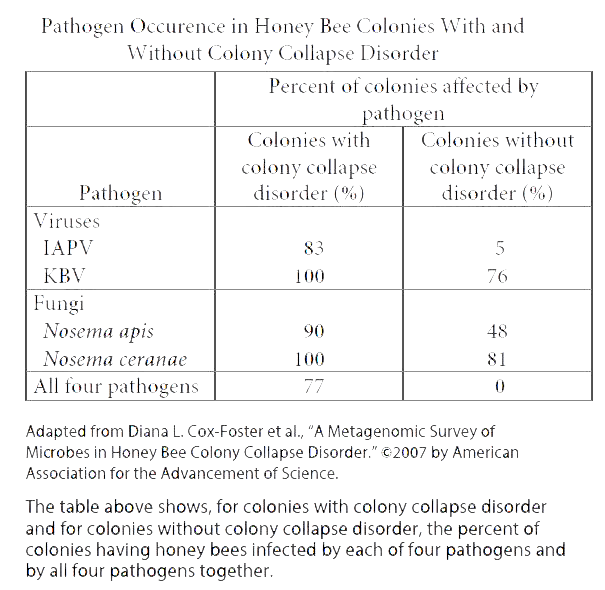
The passage most strongly suggests that beekeepers’ attempts to fight mite infestations with commercially produced insecticides have what unintentional effect?AThey increase certain mite populations.BThey kill some beneficial forms of bacteriaCThey destroy bees’ primary food source.DThey further harm the health of some bees.
Honey bees are hosts to the pathogenic large ectoparasitic mite Varroa destructor (Varroa mites). These mites feed on bee hemolymph (blood) and can kill bees directly or by increasing their susceptibility
line 5- to secondary infection with fungi, bacteria or viruses. Little is known about the natural defenses that keepthe mite infections under control. Pyrethrums are a group of flowering plants which include Chrysanthemum coccineum, Chrysanthemum
line 10- cinerariifolium, Chrysanthemum marschalli, and related species. These plants produce potent insecticides with anti-mite activity. The naturally occurring insecticides are known as pyrethrums. A synonym for the naturally occurring pyrethrums is
line 15- pyrethrin and synthetic analogues of pyrethrums are known as pyrethroids. In fact, the human mite infestation known as scabies (Sarcoptes scabiei) is treated with a topical pyrethrum cream. We suspect that the bees of commercial bee
line 20- colonies which are fed mono-crops are nutritionally deficient. In particular, we postulate that the problem is a diet deficient in anti-mite toxins: pyrethrums, and possibly other nutrients which are inherent in such plants. without, at least, intermittent feeding on
line 25- the pyrethrum producing plants, bee colonies are susceptible to mite infestations which can become fatal either directly or due to a secondary infection of immunocompromised or nutritionally deficient bees. This secondary infection can be viral, bacterial or
line 30- fungal and may be due to one or more pathogens. In addition, immunocompromised or nutritionally deficient bees may be further weakened when commercially produced insecticides are introduced into their hives by bee keepers in an effort to fight
line 35- mite infestation. We further postulate that the proper dosage necessary to prevent mite infestation may be better left to the bees, who may seek out or avoid pyrethrum containing plants depending on the amount necessary to defend against mites and the
line 40- amount already consumed by the bees, which in higher doses could be potentially toxic to them. This hypothesis can best be tested by a trial wherein a small number of commercial honey bee colonies are offered a number of pyrethrum
line 45- producing plants, as well as a typical bee food source such as clover, while controls are offered only the clover. Mites could then be introduced to each hive with note made as to the choice of the bees, and the effects of the mite parasites on the experimental
line 50 - colonies versus control colonies. It might be beneficial to test wild-type honey bee colonies in this manner as well, in case there could be some genetic difference between them that affects the bees’ preferences for pyrethrum producing flowers.
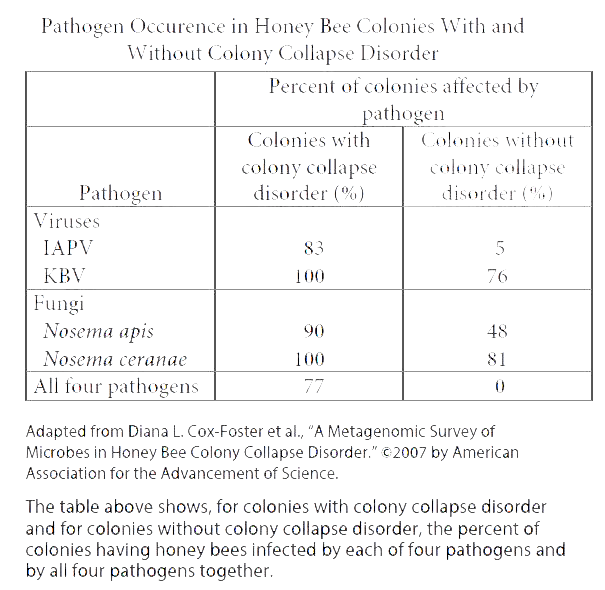
As used in line 35, “postulate” most nearly means to
View SolutionHoney bees are hosts to the pathogenic large ectoparasitic mite Varroa destructor (Varroa mites). These mites feed on bee hemolymph (blood) and can kill bees directly or by increasing their susceptibility
line 5- to secondary infection with fungi, bacteria or viruses. Little is known about the natural defenses that keepthe mite infections under control. Pyrethrums are a group of flowering plants which include Chrysanthemum coccineum, Chrysanthemum
line 10- cinerariifolium, Chrysanthemum marschalli, and related species. These plants produce potent insecticides with anti-mite activity. The naturally occurring insecticides are known as pyrethrums. A synonym for the naturally occurring pyrethrums is
line 15- pyrethrin and synthetic analogues of pyrethrums are known as pyrethroids. In fact, the human mite infestation known as scabies (Sarcoptes scabiei) is treated with a topical pyrethrum cream. We suspect that the bees of commercial bee
line 20- colonies which are fed mono-crops are nutritionally deficient. In particular, we postulate that the problem is a diet deficient in anti-mite toxins: pyrethrums, and possibly other nutrients which are inherent in such plants. without, at least, intermittent feeding on
line 25- the pyrethrum producing plants, bee colonies are susceptible to mite infestations which can become fatal either directly or due to a secondary infection of immunocompromised or nutritionally deficient bees. This secondary infection can be viral, bacterial or
line 30- fungal and may be due to one or more pathogens. In addition, immunocompromised or nutritionally deficient bees may be further weakened when commercially produced insecticides are introduced into their hives by bee keepers in an effort to fight
line 35- mite infestation. We further postulate that the proper dosage necessary to prevent mite infestation may be better left to the bees, who may seek out or avoid pyrethrum containing plants depending on the amount necessary to defend against mites and the
line 40- amount already consumed by the bees, which in higher doses could be potentially toxic to them. This hypothesis can best be tested by a trial wherein a small number of commercial honey bee colonies are offered a number of pyrethrum
line 45- producing plants, as well as a typical bee food source such as clover, while controls are offered only the clover. Mites could then be introduced to each hive with note made as to the choice of the bees, and the effects of the mite parasites on the experimental
line 50 - colonies versus control colonies. It might be beneficial to test wild-type honey bee colonies in this manner as well, in case there could be some genetic difference between them that affects the bees’ preferences for pyrethrum producing flowers.
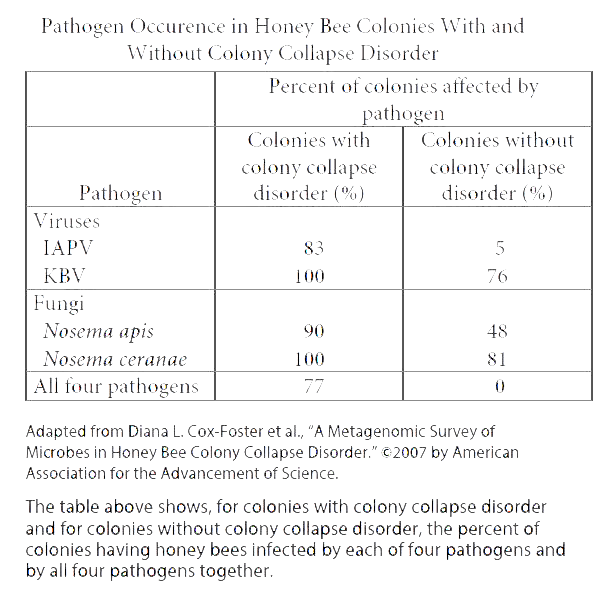
Which choice provides the best evidence for the answer to the previous question?
View SolutionHoney bees are hosts to the pathogenic large ectoparasitic mite Varroa destructor (Varroa mites). These mites feed on bee hemolymph (blood) and can kill bees directly or by increasing their susceptibility
line 5- to secondary infection with fungi, bacteria or viruses. Little is known about the natural defenses that keepthe mite infections under control. Pyrethrums are a group of flowering plants which include Chrysanthemum coccineum, Chrysanthemum
line 10- cinerariifolium, Chrysanthemum marschalli, and related species. These plants produce potent insecticides with anti-mite activity. The naturally occurring insecticides are known as pyrethrums. A synonym for the naturally occurring pyrethrums is
line 15- pyrethrin and synthetic analogues of pyrethrums are known as pyrethroids. In fact, the human mite infestation known as scabies (Sarcoptes scabiei) is treated with a topical pyrethrum cream. We suspect that the bees of commercial bee
line 20- colonies which are fed mono-crops are nutritionally deficient. In particular, we postulate that the problem is a diet deficient in anti-mite toxins: pyrethrums, and possibly other nutrients which are inherent in such plants. without, at least, intermittent feeding on
line 25- the pyrethrum producing plants, bee colonies are susceptible to mite infestations which can become fatal either directly or due to a secondary infection of immunocompromised or nutritionally deficient bees. This secondary infection can be viral, bacterial or
line 30- fungal and may be due to one or more pathogens. In addition, immunocompromised or nutritionally deficient bees may be further weakened when commercially produced insecticides are introduced into their hives by bee keepers in an effort to fight
line 35- mite infestation. We further postulate that the proper dosage necessary to prevent mite infestation may be better left to the bees, who may seek out or avoid pyrethrum containing plants depending on the amount necessary to defend against mites and the
line 40- amount already consumed by the bees, which in higher doses could be potentially toxic to them. This hypothesis can best be tested by a trial wherein a small number of commercial honey bee colonies are offered a number of pyrethrum
line 45- producing plants, as well as a typical bee food source such as clover, while controls are offered only the clover. Mites could then be introduced to each hive with note made as to the choice of the bees, and the effects of the mite parasites on the experimental
line 50 - colonies versus control colonies. It might be beneficial to test wild-type honey bee colonies in this manner as well, in case there could be some genetic difference between them that affects the bees’ preferences for pyrethrum producing flowers.

Which choice provides the best evidence for the answer to the previous question?
View SolutionHoney bees are hosts to the pathogenic large ectoparasitic mite Varroa destructor (Varroa mites). These mites feed on bee hemolymph (blood) and can kill bees directly or by increasing their susceptibility
line 5- to secondary infection with fungi, bacteria or viruses. Little is known about the natural defenses that keepthe mite infections under control. Pyrethrums are a group of flowering plants which include Chrysanthemum coccineum, Chrysanthemum
line 10- cinerariifolium, Chrysanthemum marschalli, and related species. These plants produce potent insecticides with anti-mite activity. The naturally occurring insecticides are known as pyrethrums. A synonym for the naturally occurring pyrethrums is
line 15- pyrethrin and synthetic analogues of pyrethrums are known as pyrethroids. In fact, the human mite infestation known as scabies (Sarcoptes scabiei) is treated with a topical pyrethrum cream. We suspect that the bees of commercial bee
line 20- colonies which are fed mono-crops are nutritionally deficient. In particular, we postulate that the problem is a diet deficient in anti-mite toxins: pyrethrums, and possibly other nutrients which are inherent in such plants. without, at least, intermittent feeding on
line 25- the pyrethrum producing plants, bee colonies are susceptible to mite infestations which can become fatal either directly or due to a secondary infection of immunocompromised or nutritionally deficient bees. This secondary infection can be viral, bacterial or
line 30- fungal and may be due to one or more pathogens. In addition, immunocompromised or nutritionally deficient bees may be further weakened when commercially produced insecticides are introduced into their hives by bee keepers in an effort to fight
line 35- mite infestation. We further postulate that the proper dosage necessary to prevent mite infestation may be better left to the bees, who may seek out or avoid pyrethrum containing plants depending on the amount necessary to defend against mites and the
line 40- amount already consumed by the bees, which in higher doses could be potentially toxic to them. This hypothesis can best be tested by a trial wherein a small number of commercial honey bee colonies are offered a number of pyrethrum
line 45- producing plants, as well as a typical bee food source such as clover, while controls are offered only the clover. Mites could then be introduced to each hive with note made as to the choice of the bees, and the effects of the mite parasites on the experimental
line 50 - colonies versus control colonies. It might be beneficial to test wild-type honey bee colonies in this manner as well, in case there could be some genetic difference between them that affects the bees’ preferences for pyrethrum producing flowers.
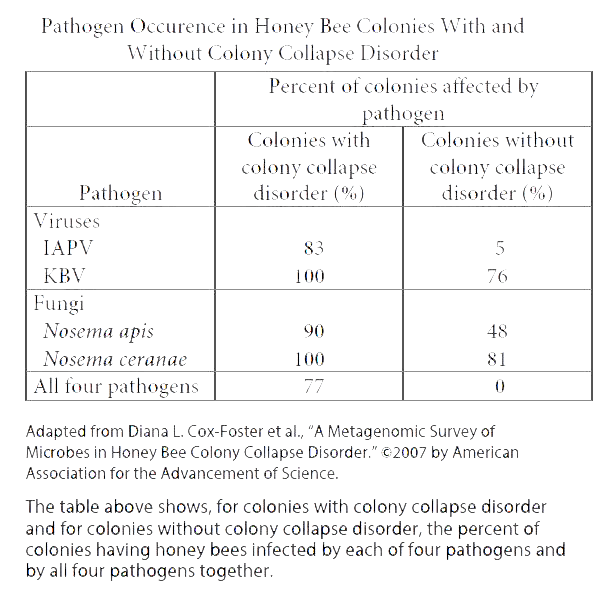
The main purpose of the fourth paragraph (lines 42-50) is to
View SolutionHoney bees are hosts to the pathogenic large ectoparasitic mite Varroa destructor (Varroa mites). These mites feed on bee hemolymph (blood) and can kill bees directly or by increasing their susceptibility
line 5- to secondary infection with fungi, bacteria or viruses. Little is known about the natural defenses that keepthe mite infections under control. Pyrethrums are a group of flowering plants which include Chrysanthemum coccineum, Chrysanthemum
line 10- cinerariifolium, Chrysanthemum marschalli, and related species. These plants produce potent insecticides with anti-mite activity. The naturally occurring insecticides are known as pyrethrums. A synonym for the naturally occurring pyrethrums is
line 15- pyrethrin and synthetic analogues of pyrethrums are known as pyrethroids. In fact, the human mite infestation known as scabies (Sarcoptes scabiei) is treated with a topical pyrethrum cream. We suspect that the bees of commercial bee
line 20- colonies which are fed mono-crops are nutritionally deficient. In particular, we postulate that the problem is a diet deficient in anti-mite toxins: pyrethrums, and possibly other nutrients which are inherent in such plants. without, at least, intermittent feeding on
line 25- the pyrethrum producing plants, bee colonies are susceptible to mite infestations which can become fatal either directly or due to a secondary infection of immunocompromised or nutritionally deficient bees. This secondary infection can be viral, bacterial or
line 30- fungal and may be due to one or more pathogens. In addition, immunocompromised or nutritionally deficient bees may be further weakened when commercially produced insecticides are introduced into their hives by bee keepers in an effort to fight
line 35- mite infestation. We further postulate that the proper dosage necessary to prevent mite infestation may be better left to the bees, who may seek out or avoid pyrethrum containing plants depending on the amount necessary to defend against mites and the
line 40- amount already consumed by the bees, which in higher doses could be potentially toxic to them. This hypothesis can best be tested by a trial wherein a small number of commercial honey bee colonies are offered a number of pyrethrum
line 45- producing plants, as well as a typical bee food source such as clover, while controls are offered only the clover. Mites could then be introduced to each hive with note made as to the choice of the bees, and the effects of the mite parasites on the experimental
line 50 - colonies versus control colonies. It might be beneficial to test wild-type honey bee colonies in this manner as well, in case there could be some genetic difference between them that affects the bees’ preferences for pyrethrum producing flowers.
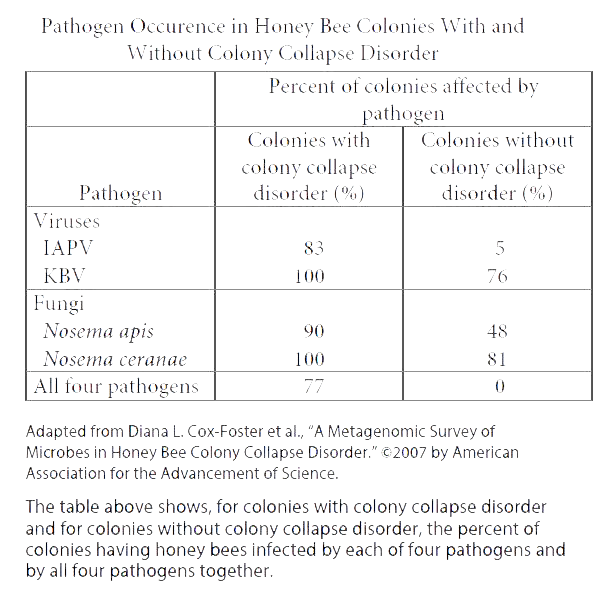
An unstated assumption made by the authors about clover is that the plants
View Solution
